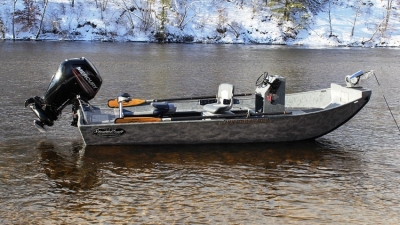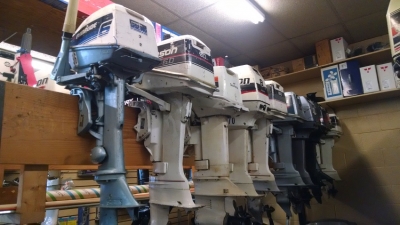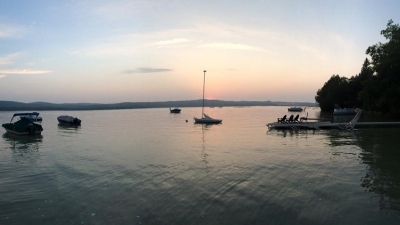Blog
Jet Motors: The Right Outboard for River Fishing
Like every body of water, river fishing comes along with uniqUe obstacles: shallow water to maneuver with visible or hidden debris -- added risk if the bottom is rocky. These common risks play a big role in jet motors gaining popularity amongst Michigan river anglers.
An outboard jet motor sits on the outside of a boat, just as a propped outboard does, and appears the same in many ways. They're different in the way the motors get power, direction, and force. While a propped motor gets its force from prop propulsion, a jet outboard relies on a water pump, which sucks water in and pushes it back out to move the boat forward. This difference is the root of jet motors biggest advantage: shallower water capabilities -- especially useful in river fishing.
In with the Old, Out with the New: Used Motors
It's no lie that things can get pretty quiet around here when the Michigan winter hits. Once winterizing starts to slow down, our mechanics turn their focus over to used motors. We use the winter months to stock our used motor room and shelves with various, dependable, and thoroughly checked motors. Here's a little glimpse into the steps we go through to get these motors back onto the shelves and water-ready for boating season:
Fall Boating Perks
Fall is approaching and it will bring the somber end-of-summer vibes with it. Pack away your swimsuit, enjoy your tan while you have it, and kiss the warm weather goodbye - but whatever you do, don't send your boat in for storage just yet. Summer boating is nearly impossible to compete with, but that doesn't mean fall boating should be overlooked completely; it's still good for something.
It's good for your game
With a change in location and bait, fall can be a great time for bass fishing. The colder weather and water temperatures will coax the bass into shallower waters. It's best to use bait that does well in shallower waters: crankbait, spinner bait, or jerkbait to list a few. Because bass are more aggressive in the fall, preparing for cold months with little feeding ahead, they're willing to work for their food - so it will be especially beneficial to use lures that look like the shad that they're feeding on. Regardless of what type of bait you are using, try and mimic the shad with the color.
6 Necessities for the Perfect Boating Day
#1 Good Weather  Some of the most important parts of a good boating day are weather, company, and an ice cold drink. Pay attention to the weather forecast and the rest will follow. When there's nice weather, the friends will find the boat. When the friends find the boat, chances are they will come along with a full cooler. All you need to do is make sure your koozie is ready.
Some of the most important parts of a good boating day are weather, company, and an ice cold drink. Pay attention to the weather forecast and the rest will follow. When there's nice weather, the friends will find the boat. When the friends find the boat, chances are they will come along with a full cooler. All you need to do is make sure your koozie is ready.
#2 Pre-Departure Checks
I know, I know: maintenance isn't fun and the water is calling your name. But before you load up your friends and cooler, you should probably make sure your motor and boat are as ready as you are. There are a few easy things you should check before leaving dock. The biggest no-brainer, and probably most important: check your gas level. Nothing like getting stranded to ruin your day out on the water. Also make sure your engine oil and coolant are at a good level, check your anchor rope for chafe or wear, and run your motor to make sure it is having a smooth start up.
#3 Bragging Rights
Are you packing on the passengers for a ride, maybe anchoring at a sandbar for a little bit? Or are you loading up the wakeboard, skis, and tubes for a day of watersports? Decide this before you pick out which prop you are going to use for the day. One prop could offer better acceleration and hole shot for water sports, while another prop might be better at offering pulling power for packing on lots of friends. Using the right prop will help you optimize your boat's performance, ideal for the perfect boating day, and help you earn some bragging rights along the way. It can't hurt to have another prop handy with the right tools to change it. This can give you options as well as a backup if anything should happen.
#4 Peace of Mind
Grab enough life jackets, make sure your extinguisher and flares aren't expired, update your registration, and put on your sunblock - quick, easy, and worth it. Peace of mind: check.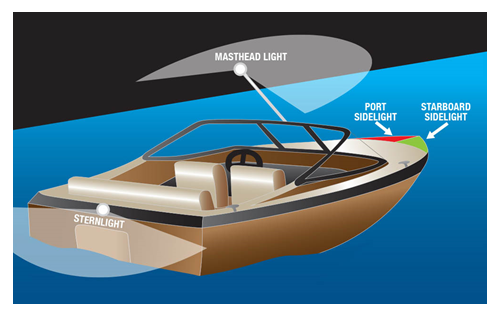 #5 Unknown End Time
#5 Unknown End Time
Summer is winding down which means the hours of sunlight are too. But, with the correct lights and knowledge of night time boating, you won't have to worry about getting home before the sun is down. The speed and waterskiing may be done once the sun is, but that doesn't necessarily mean it's time to dock. When it starts to get dark, pay attention to your speed. Many places have reduced speed limits for night time, sometimes even an idle speed. With limited sight, it's better to go slower regardless of the rules. Make sure you have the correct lights, that their bulbs aren't dead, and you know how to use them correctly. When driving a car, the solution is always headlights. Boating is very different, headlights can create difficult reflecrtions on the water which makes night time driving trickier. Different colored lights mean different things, so make sure you are aware of what your lights may mean to other boaters before staying out in the dark.
#6 Plans to do it Again
Ending a day on the water with plans to do it again is to be expected. Especially after its been the perfect boating day. You can make the plans, but you can't assure your boat and motor will make an appearance without a little bit of after-use care. If you're looking for the bare minimum care: rinse it off and put on the cover. If you want to really take care of it: flush out the motor, check for any leaks, and consider your fuel level. If you're next plans are coming up soon, it's best to fill up the gas tank. If the next ride might not be for a while, try to run through your tank if you can. You boat and motor will thank you. 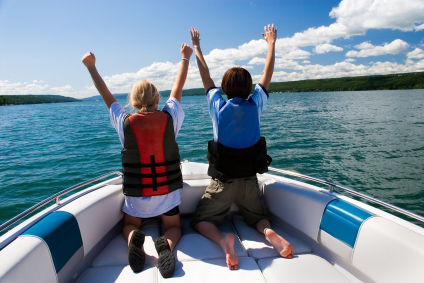
Boat Maintenance - 3 Spots Not to Miss
Somethings are out of sight, out of mind - a boat's accumulation of bacteria, grease, or odor should not be one of those things. There are a few covered parts of a boat that really need to get some attention in order to keep your boat in good shape. Often, the places you can't see are the places that could use the most TLC; like the live well, bilge, or gunk that collects in your engine. Cleaning and maintaining the cleanliness of your boat and outboard can be easy and worth it.
Maintaining your engine
All maintenance serves the same purpose; it helps avoid damages while also getting the most out of your outboard's performance. When it comes to boats and motors, a shiny exterior is nothing without a shiny interior. Cleaning your engine is important regardless of what kind of water you are cruising through. De-greasing the inside of your engine and removing all the gunk and dirt should become an annual part of your end-of-season care. Using an anti-corrosive, like WD-40, helps remove all the possibly troublesome grime from your engine.
Once you have a sparkling engine interior, flushing out your outboard with fresh water helps maintain a healthy engine. If you're cruising through salt water, flushing is recommended after every use. Left over salt sitting in your engine can be harmful. Even when going through fresh water, if it is especially sandy or dirty, flushing after use is a good precaution. Flushing is also helpful because it helps your engine cool down. With a set of engine ear muffs and a garden hose, flushing out your engine can be quick and painless. Attach ear muffs to your lower unit so they're covering the pickup, attach the garden hose to the side of the ear muffs, and start flushin'. With the engine and garden hose both running, the water is sucked up by the fuel pump and through the engine. By flushing regularly and keeping up with consistent engine maintenance you can prevent issues before they get too major.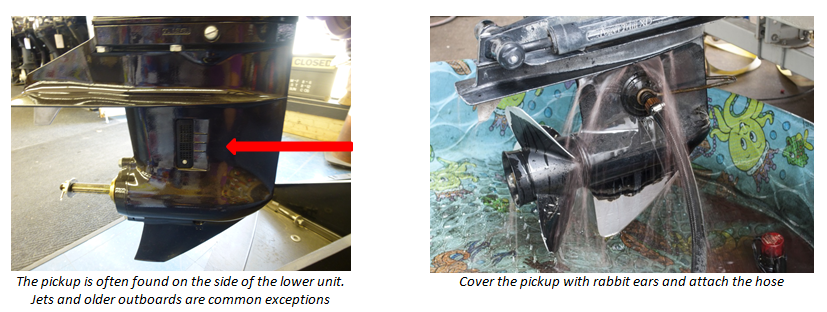
Maintaining your bilge & livewell
The bilge of your boat can have an odor, collect bacteria, or rust and corrode the equipment that sits there. With that being said, it's clear why keeping your bilge clean is advised. Bilges can get dirty and not all sections of the bilge are easy to reach, but cleaning all of the areas you can will make a huge difference.There are different options for bilge cleaner, but going with a biodegradable cleaner can have advantages. Products that aren't biodegradable can harm the water; they require careful use. With a biodegradable cleaner you don't have to be quite as cautious. After applying the cleaner, let it soak before scrubbing: why not let the cleaner do some of the work for you? Letting it sit and soak gives it a chance to de-grease, making the rinse easier.
How many times have you caught a fish, put it in the live well, took the fish out, and gone about your business? Probably atleast a few times. How many times have you given your live well a good scrub-a-dub? Hopefully at least a few times. Fish aren't clean by any means, so chances are your live well isn't either. Probably one of the easiest things to clean, the live well only requires a little scrubbing with anti-bacterial soap. After washing, especially before boat storage, make sure your live well is dry. Storing a boat with a wet live well, even clean moisture, can easily grow bacteria and reverse your hard work.
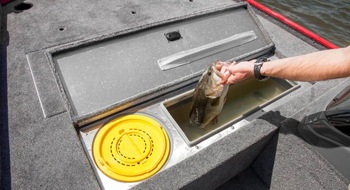
A nice boat can help ensure weekend plans, fresh fish dinners, and bragging rights. A dirty boat, on the other hand, can potentially lead to odorous boat rides or hefty mechanic bills. No doubt keeping your boat and outboard clean will definitely pay off. Stop by or call Van's Sport Center with any questions or boating needs!
Suzuki's DF200A: The Whole Shebang
Suzuki Marine brings a lot to the table; motors with lots of power, motors with efficiency, and motors with style. With their DF200A, however, they have combined all those attributes in one outboard.
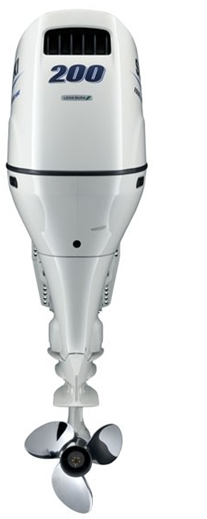 It's powerful
It's powerful
Often when searching for added power you get stuck packing lots of bulky weight onto your boat. That isn't the case with Suzuki's DF200A four stroke outboard. One of the biggest sources for this motor's praise is its power-to-weight ratio. It holds a four cylinder block that can also meet the performance more typically seen in V6 outboards. Its impressive torque at lower rpms and fast acceleration are more typical characteristics for V6 motors, but with an efficiently designed engine like this one you can get the best of both worlds.
It's intelligent
With three different sensor systems and qualities that lead to great fuel economy, this motor has an engrained sense of efficiency. It has a water detection system which increases the moto'rs reliability; especially beneficial with the threats posed by increasing amounts of ethanol in fuel. Along with the water detection, it has a knock and O2 sensor. Both of these sensors send information to the ECM that helps optimize the engine's performance. It uses the Lean Burn technology which allows this motor to optimize the fuel-to-air mixture and provide improved fuel economy. This motor optimizes performance, optimizes fuel use, and optimizes reliability with sensor use -- I told you it was intelligent.
It's sleek
This outboard offers power, fuel economy, low-end torque: all packed into one sleek external body. The DF200A is lightweight and slim, weighing in at 498 lbs. The lighter weight of this motor widens the range of boats that it can call home. Older boats are often confined to lighter 2 stroke outboards, but this light 4 stroke model poses as a more powerful option. Also, because of its slim profile it would be a good motor for twin-engines.
Whatever you are looking for in a re-power the DF200A is definitely one to consider. It'll give your boat a new look, your rides more power, and you a motor you can count on - all in one shebang.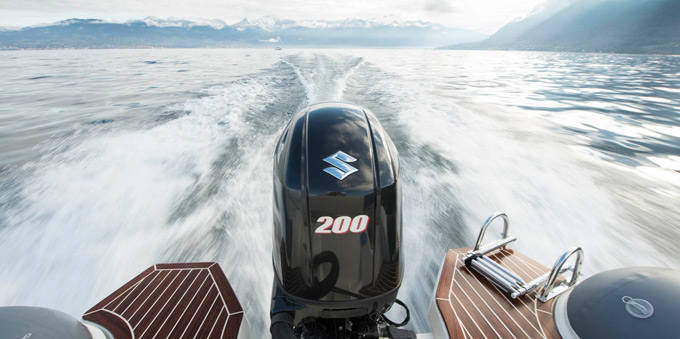
Keeping Up With Oil - Happy Engine; Happy Owner
Changing your motor's oil is no different from any other maintenance work; keeping up with it consistently will help avoid damages and better the longevity of your motor's life. Maintaining clean and full oil in your boat can help keep the engine running smooth for a lot longer. A lubricated engine makes for a happy engine--and a happy owner. 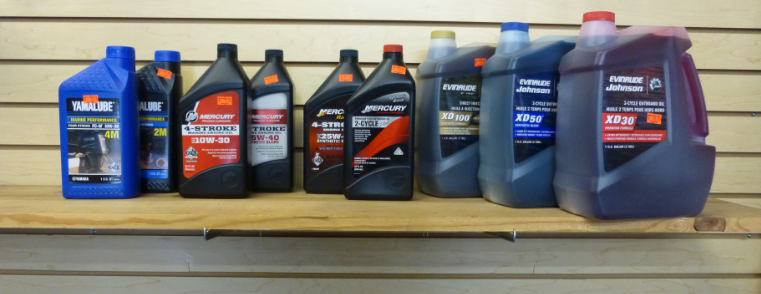 How Often to Add Oil
How Often to Add Oil
Depending on what type of outboard you are running, oil maintenance will be different. With 2-Stroke outboards the oil goes straight in with the fuel which means there is no changing, per say, just re-adding. With 4-stroke engines the oil is kept separate and the engine doesn't burn through it the same way 2-Stroke engines do, so you have to change it rather than just add more. For most 2 Stroke outboards the fuel to oil ratio is 50:1, so for every 50 gallons of fuel you use, you should add 1 gallon of oil. Older engines may differ in required oil ratios, depending on their year. For four stroke outboards, it is recommended that you change your oil every 50-100 hours or, to simplify, once a year. Depending on the frequency that your motor is used, it may be beneficial to change oil more often.
What Type of Oil to Use
When picking out the best oil for your outboard there are advantages to using brand compatible oil. Outboard branded oils are specially formulated for that brand of motors. When using Evinrude's XD oil in an ETEC, for example, you are assuring that your oil is meeting your engine's standards. All outboard brands make outboard oil and it is manufacturer recommended to use your outboard's brand for best results.

It's an ongoing discussion: is conventional or synthetic oil better for your engine? Sometimes it just depends on preference. Conventional is a mineral based oil while synthetic is chemically created, or man-made. Conventional oil is cheaper than synthetic oil, but in the long run sometimes synthetic can be cheaper. Your engine will burn through less oil when using synthetic which can make the extra expense worth it. If you're looking for something in the middle, there is also a synthetic blend. A synthetic blend is a mix of conventional (30%) and synthetic (70%) and it offers some of the benefits from synthetic at a lower price.
Tips For Changing Your Oil
Taking your boat into a service department for an oil change is quick and well worth the time and money spent. However, with the right tools and information about your motor, changing your oil yourself can be worth it as well. Here are a couple of tips for changing the oil in your 4-stroke outboard yourself.
1. Run your engine first
This one small step will make a huge difference. When oil is cold it gives the dirt and grime a chance to settle and get left behind, but when oil is hot it suspends the contamination and allows for it to be removed with the oil. Running the engine beforehand also makes it easier because heating up the oil thins it out, making it easier to drain. Run your engine for about 5 minutes before changing the oil and you won't regret it.
2. Prepare for disposal and drips
When changing oil it is very important to be cautious of oil spills. Before changing your oil, you should make sure that you have something ready to catch drips and old oil for disposal. If draining your oil by removing the drain plug, a garbage bag (or two) can be attached to your motor for direct disposal. Lining the trash bag with a cardboard box, in the place where the bag and outboard meet, makes for a more spill free draining. On top of that, you can use absorbent mats or rags to help catch unexpected drips and spills.
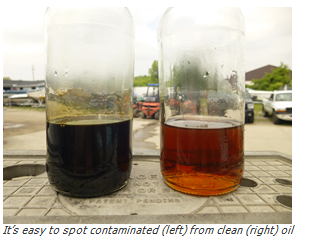
3. Out with the bad...(filter too!)
There are different methods to ridding of the contaminated oil. The simplest, yet sometimes messiest, way is to remove the drain plug and let it pour out. This way can be easy, but catching the old oil and disposing is not as simpleas other methods. Another option is to use a manual hand pump or other systems that can come with an attached container for disposal. Usually these manual tools get to the oil through the dipstick tube of your engine. When you're changing your filter, it's beneficial to change your filter as well. A lot of grime can build up there, might as well kill two birds with one stone.
5. ...in with the good
After you've drained your old oil, its time to fill 'er back up. Before doing so, know how much oil your outboard needs, draining out after overfilling can be a pain. This information can be found in the owners manual. Once you got that lucky number, remove the filler plug, pour in the new oil, and check the level using your dipstick.
If your outboard seems like it would be an easy change, save yourself money and time by doing so yourself. However, there are always service departments ready to help. Don't hestitate to contact or stop in to Van's Sport Center with any boating needs!
Kicker Motors - The Perfect Sidekick
Kicker motors, also known as spare outboards, are motors that sit next to a bigger, main outboard and can serve a couple of different purposes. They typically are seen in the 10hp or less range. The simplest use for a kicker is as back up. In events where your main outboard fails, and you don't have The Hulk to paddle you ashore, a kicker is a great thing to have. For more recreational needs, it can be used to steer sailboats. This is more often seen in southern areas, such as Florida. In northern areas, such as Michigan, Kickers are more commonly used for trolling. When you're trying to catch those salmon and trout in Lake Michigan, a kicker will come in handy. They allow you to slow down to a trolling speed.
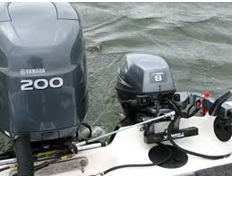 Kickers and trolling motors may seem to be one in the same because of their very similar purpose. However, there are big differences that set them apart. There are advantages to a trolling motor; they run on battery and can provide pull from the front (with a bow motor) which can provide better control. However, that doesn't mean it is always your best option. There are advantages that come with a kicker outboard that may just give trolling motors a run for their money. A kicker outboard is not only great for trolling, but it also provides a great backup for when your main outboard is failing. If you try to use a trolling motor as a secure backup, it would require having spare batteries. Batteries put heavy weight on a boat and take up space; with a kicker motor you don't have to worry about those--you get the accountability of a back-up outboard without needing a backup battery for the backup. Kicker motors provide a way to troll, while also providing a better sense of security.
Kickers and trolling motors may seem to be one in the same because of their very similar purpose. However, there are big differences that set them apart. There are advantages to a trolling motor; they run on battery and can provide pull from the front (with a bow motor) which can provide better control. However, that doesn't mean it is always your best option. There are advantages that come with a kicker outboard that may just give trolling motors a run for their money. A kicker outboard is not only great for trolling, but it also provides a great backup for when your main outboard is failing. If you try to use a trolling motor as a secure backup, it would require having spare batteries. Batteries put heavy weight on a boat and take up space; with a kicker motor you don't have to worry about those--you get the accountability of a back-up outboard without needing a backup battery for the backup. Kicker motors provide a way to troll, while also providing a better sense of security.
Initially, the kicker can be a little bit pricier than alternative trolling options. But after that sometimes-painful purchase, they have qualities that make them cost effective. First and foremost, using a kicker motor helps you save on gas. Trolling with a kicker offers great gas to time ratio, which helps save on the gas you would have been using with your main outboard. Along with gas, they help prevent putting unwanted hours on your main outboard. By preventing wear and tear on your main outboard, you maintain the longevity of your main outboard. In addition, a little extra bonus: if both your main and kicker outboard are compatible, you can link up gas tanks so you don't have to fill separately.
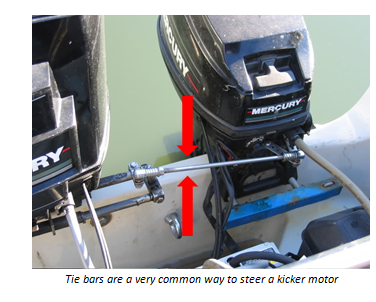 When using a kicker motor, there are a few different steering options. A lot of kicker motors will come with a tiller handle; a tiller handle is an easy way to steer especially when it comes with the motor. However, there are a few other options that allow you to move further away from your motor while on the go. The cheapest and simplest way would be using a tie bar to connect your kicker to your main outboard. Although it can be the cheapest option, it can make outboard maintenance a little more complicated. Auto-pilot is a pricier way to steer your kicker, however it offers a lot of advantages. Auto-pilots are great at keeping you on course and adjusting to different conditions. With a little wind, the auto-pilot will correct itself to keep you on track without having to fight against it yourself. Hydraulic is the fourth steering option. Hydraulic is a much easier and effective way to connect your two motors with more options.
When using a kicker motor, there are a few different steering options. A lot of kicker motors will come with a tiller handle; a tiller handle is an easy way to steer especially when it comes with the motor. However, there are a few other options that allow you to move further away from your motor while on the go. The cheapest and simplest way would be using a tie bar to connect your kicker to your main outboard. Although it can be the cheapest option, it can make outboard maintenance a little more complicated. Auto-pilot is a pricier way to steer your kicker, however it offers a lot of advantages. Auto-pilots are great at keeping you on course and adjusting to different conditions. With a little wind, the auto-pilot will correct itself to keep you on track without having to fight against it yourself. Hydraulic is the fourth steering option. Hydraulic is a much easier and effective way to connect your two motors with more options.
Most outboard brands offer smaller horsepower motors that can be used as kicker motors. Mercury has a ProKicker FourStroke series that is light weight, fuel efficient, and offers great portability. The Yamaha T9.9 also gets great reviews when being used as a kicker motor. The T9.9 offers longer tiller handles for easier steering. It's a great motor for trolling with slightly bigger boats. Suzuki has a DF9.9 motor that is great as a kicker, comes with a power till and EFI (Electronic Fuel Injection).
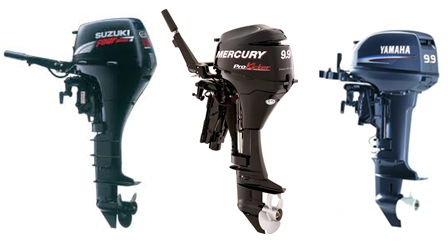
A big part of picking out a kicker motor is preference. With the right knowledge of your options and what you want, you're well on your way to finding the kicker motor that fits your needs. Don't hesitate to stop in and let us show you what we, and our selection of motors, have to offer!
More...
3 Tips to Finding the Right Outboard Prop
Here at Van's, we get a lot of customers looking for propellers, either used or new. Finding the right prop can be crucial to getting the most out of your boat and motor while also avoiding damages. There's a lot of things to consider, but it helps to know what you are looking for and why. Here's a few tips to keep in mind.
1: Don't go big or go home: Find the right pitch and diameter
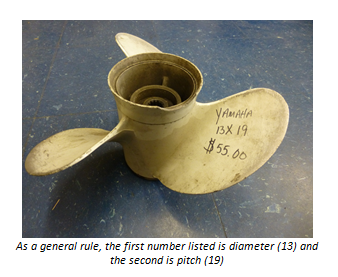
The first thing to consider when finding a prop is diameter and pitch. Diameter is the distance from the center of the hub to the tip of any blade, doubled. Typically smaller diameter goes with smaller engines and larger goes with larger engines. Pitch refers to the theoretical distance, in inches, that a propeller moves forward in one revolution. When looking for a prop, it's easy to assume the bigger the pitch, the faster, the better. But it's important to make sure your engine can keep up with the pitch--you want to find a pitch that optimizes performance while still staying in the suggested rpm range at wide open throttle (WOT).
High pitch will give optimal performance as long as your engine has enough power to keep up. Not to mention, lower pitch props can have their advantages too: they can increase acceleration and pulling power. Lower pitch provides better hole shot. Using a prop with too much pitch can lead to engine damage and more wear and tear on your motor. Sometimes finding the right pitch is unfortunately a matter of trial and error. A nearby dealer or marina can help you leave with the right pitch. Make sure to come knowing the type of engine, horsepower rating, weight, hull style, and what type of propeller you are currently running.
2: Match your prop to your boating style
Your weekend plans matter. When searching for a prop with the right pitch, it can be helpful to take into consideration what you are using your engine for. Do you want to see what kind of speed you can get? Are you looking to take a slow and steady cruise with friends? Or do you want a pitch with better hole shot to help you look like a watersports pro? It matters.
There will be a couple of different pitches that could be used for your engine. Most of the time there is a prop that best suits your engine and then there will be a prop that best suits your needs and activity. If you do a lot of watersports and aren't too concerned with having top speed at WOT, then you will want to go with a lower pitch. A lower pitch will be able to provide better acceleration and hole shot. Also, if you are willing to give up speed in order to have more friends (weight) on your boat, a lower pitch will also suit you because it can offer better pulling power. On the flip side, if you are a solo speed demon who likes to take fast rides with fewer people, a higher pitch is for you. It may take a little longer for your boat to plane, but you have a higher potential speed at WOT.
3: Decide on a material - Aluminum or Stainless-Steel
Let's start with a clean slate when it comes to what material is better: neither. They each have advantages - different advantages - but they both have them nonetheless.
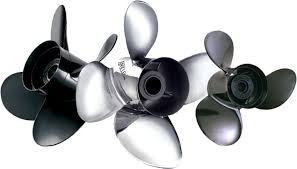
Aluminum Propellers
Aluminum propellers cost less. That's the biggest advantage, plain and simple. Cheaper price also transfers into getting them fixed; aluminum repairs are often half the price of stainless-steel repairs. Aluminum props also offer a wider range; if you are looking for a specific or specialized propeller you have a good shot of finding it in aluminum. If you're willing to give up a little durability in order to save (more than) a few bucks--aluminum is the way to go.
Stainless-Steel Propellers
Stainless-steel propellers offer better durability and performance. They're less likely to get damaged when bumping into a hard surface. However, when a collision does occur, the damage can sometimes be more server: stainless-steel at times can be too tough, too stubborn. When you collide with something, the blades can refuse to give and the strong force can move into the lower unit, causing damages there. That being said, though, they still provide better performance and durability. The stainless-steel propellers cost more, both to buy and repair, but those extra dollars won't go unnoticed.
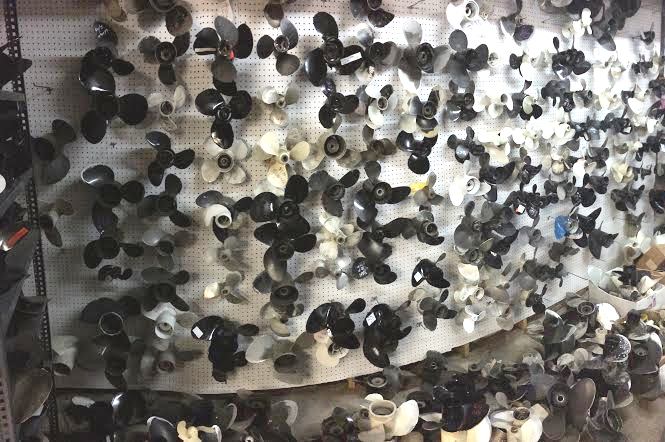 Van's offers a wide variety of propellers: new or used, aluminum or stainless-steel
Van's offers a wide variety of propellers: new or used, aluminum or stainless-steel
It seems daunting, finding the right prop for your engine. But the work and time is worth it. Finding the right prop can assure you are getting the most out of your engine, avoiding costly damages, and altering your boat to best suit you. Don't hesitate to stop in to Van's Sport Center for help in finding the right prop for you--it's what we are here for!
Boating Safety - Know Before You Go

As discussed previously, protecting your motor from ethanol is very important. However, even more important: protecting boat passengers by paying attention to boat safety. Recreational boating is a great way to pass the summer weekends, but a few quick and easy precautions can assure that you are doing so without risking the safety of you or your passengers. The US Coast Guard offers free Vessel Safety Checks, which is a great way to get peace of mind and assurance that you're cruising on a safe boat. Although there are certified examiners to do these checks, that doesn't mean you can't also check yourself. There are still many things that any Joe-Schmo can pay attention to when boating.
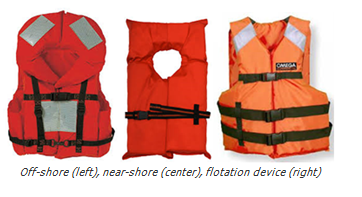
Life Jackets
Life Jackets may not be the comfiest - but wearing them is worth it. Enforced by the US Coast Guard, boats must carry one life Jacket, or personal flotation device (PFD), for each passenger. Also, any passenger under the age of 13 has to wear a life jacket. Not only is it important to have one, it is also important to have one that best matches your style of boating. There are five types of personal flotation devices: off-shore life jackets, near-shore life jackets, flotation aids, throw-able devices, and special-use devices. Although each type is meant to fulfill the same purpose, they have different advantages.
There are five types; however the most common PFDs are off-shore, near-shore, and flotation devices. Off-shore life jackets are the best for rough and remote waters because they provide the best buoyancy. Off-shore life jackets would be best when rescue may be delayed. Near-shore life jackets are better for inland and calmer waters; they only go around your neck so they're better for quick rescues. Flotation devices are the best for more freedom of movement; they're typically used for watersports because of this.
Lights, Signals, Fire Extinguisher
Along with life jackets, all vessels are required to have approved visual distress signals, fire extinguishers, and navigation lights. It is important to verify that your visual distress signals are not expired. While they still may be useful, they will not pass the U.S. Coast Guard regulations. For the fire extinguishers, it's important to make sure that they are in good, operable condition. At night, it is important to have the correct navigation lights; other boats on the water need to be able to spot you in the dark and vice versa. Not only are these three things important because of regulations, they will also help maintain safety while boating.
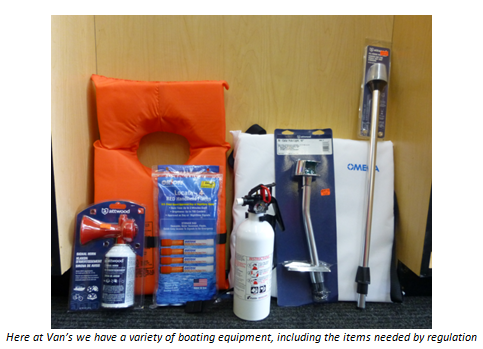
Correct Registration and Documentation
There are safety tips that protect you, and then there are safety tips that protect your time and fun. Failing to have correct documentation and visible registration can put a stop to your time on the water. Vessels must be visibly registered with display of registration numbers. Registration numbers must be visible in block letters, in a color that contrasts the back of the boat, and no smaller than 3 inches in height. Getting pulled over for a lack of registration would be quick way cut water time short, but it is also a very easy problem to avoid.
Vessel safety checks, offered by the U.S. Coast Guard, take a much closer look at the safety of your boat. Along with PFDs, registration, fire extinguishers, distress signals, and navigation lights, they check:
Upon passing a VSC, you recieve a decal for your boat that lets water police know that you are up to par with current regulations. There are different ways to efficiently check your boat: a personal check using a the VSC online checklist, a virtual check which requires you to answer a series of questions about your boat online, or requesting and scheduling a VSC with a certified examiner. All the options are offered for free, take minimal time, and are a great way to get peace of mind during the boating season.
Fighting Against Ethanol Damage
It's only the beginning of summer and the service department here at Van's Sport Center is already full of boats and motors needing repairs; all fingers are pointed at ethanol. It's pretty clear that ethanol is the boating industry's kryptonite, with it's ability to cause costly damages to a boat engine and steer people away from boating. With some fuels even having a 15% ethanol blend, the risk of using ethanol fuel grows. However, it doesn't mean its time to throw in the towel. Ethanol may be here to stay, but there are still ways to avoid it's negative effects and protect your motor. Here are a couple things that will help you stay on the water and out of the shop:
Recreational fuel is your friend
Most of the time fuel offered at a gas station is ethanol based fuel with at least 10% ethanol blend, which can be harmful. Some places may even be using 15% blend. Ethanol is alcohol and it pulls moisture from the air, which means ethanol-based fuel can cause a variety of damages. For example, ethanol can cause your fuel line hose to fall apart and almost become mushy, causing your fuel line to plug. This is just one area of your motor that ethanol can damage. The breakdown of parts such as the fuel hose, creates residue which can cause goop or build up in other parts of the engine, leading to other problems. One way to prevent these damages and avoid needing repairs--use recreational, non-ethanol fuel. Many places offer a non-ethanol fuel, which can cost a little more but because it is better for an engine it could save you from an expensive trip to the shop in the future.
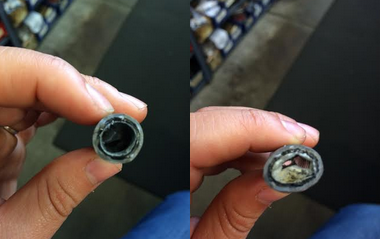
The left side shows a fuel line hose with no ethanol damage, while the right side shows a hose that is almost clogged from ethanol breaking it apart.
Treatments: additives and stabilizers
Although non ethanol fuel is ideal, there are treatments that can make using ethanol fuel not as risky. There are a wide variety of treatments you can use to prevent ethanol damage to your motor and they all help maintain a healthy engine. Ethanol can damage your motor when it separates from fuel because of the water that it absorbs, but these treatments help stabilize your fuel to help prevent damage. They are meant to provide protection during off-season storage but also during operational use; periods of storage often require a higher concentration of the treatment.
BRP has a treatment called 2+4 which is proven to be very effective and recommended to be used at every fill up for maximum year-round protection. Mercury has a 3 step treatment which includes their Quickare, Quickleen, and Quickstor. While Quickare and Quickleen are used to protect during the season, Quickstor is made to be used before storage and provide protection throughout the off-season. Amongst these, there are many other treatments available: such as, Seafoam engine treatment, Yamalube, Starbright fuel additive, and Sta-Bil fuel treatment and stabilizer.

There are a lot of different treatments and they're all aimed to protect your engine.
Fuel tank levels matter
Whether or not a full fuel tank is more vulnerable or safe is a question that is still in debate. While some say that a full tank allows less room for moisture to collect, others say that a full tank has more ethanol which will pull in more moisture than an empty tank with small amounts of ethanol. 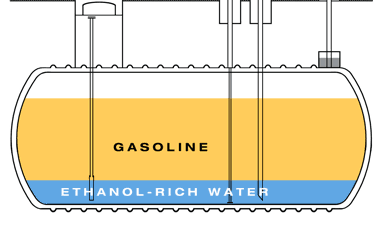 Because it is hard to determine which one is better, a good solution is to determine a safe level for your fuel tank depending on the amount of expected future use. If you have a boat that is used often, maintaining a full tank would be advantageous. Cars are not at as big of a risk for ethanol damage because of their frequent use, so when a boat is used frequently a full tank does not increase the risk of damage. However, when you have a boat that is not used quite as frequently or being stored, running through the fuel completely will help eliminate risk of damage.
Because it is hard to determine which one is better, a good solution is to determine a safe level for your fuel tank depending on the amount of expected future use. If you have a boat that is used often, maintaining a full tank would be advantageous. Cars are not at as big of a risk for ethanol damage because of their frequent use, so when a boat is used frequently a full tank does not increase the risk of damage. However, when you have a boat that is not used quite as frequently or being stored, running through the fuel completely will help eliminate risk of damage.
While ethanol certainly poses a threat to outboards, there are things to do to that can help you avoid this or lower the intensity of the damages. Using the right fuel, treating your fuel and paying attention to the level of your gas tank are small tasks that can offer a big pay off. Don't hesitate to contact Van's Sports Center with any questions or boating needs!
Mercury Releases Their Next Generation Of 75hp, 90hp, and 115hp Outboards
 Mercury has always been an innovative and competitive company, so it should be no surprise that they have totally rethought their line of 75hp, 90hp, and 115hp Outboards. Mercury designed these new outboards so that a lighter, more compact motor can be hung on your transom while still offering better performance, hole shot, and towsport capability than the earlier models. Some other great features that were added into the design of these new outboards include higher fuel savings, hassle free maintenance, and a rugged construction.
Mercury has always been an innovative and competitive company, so it should be no surprise that they have totally rethought their line of 75hp, 90hp, and 115hp Outboards. Mercury designed these new outboards so that a lighter, more compact motor can be hung on your transom while still offering better performance, hole shot, and towsport capability than the earlier models. Some other great features that were added into the design of these new outboards include higher fuel savings, hassle free maintenance, and a rugged construction.
The new Mercury Four Stroke outboards feature a 2.1-liter, four-cylinder, eight-valve, single-overhead-cam design which provides more horsepower and torque as well as offers greater hole shot, acceleration, and top speed. At the 115hp rating, only the 2.4-liter Honda BF115 offers more cubic inches, but the Honda is also 120 pounds heavier than the new Mercury. The new Mercury 115hp weighs in at 359 pounds, which is the lightest model in its horsepower rating. It is an amazing 40 pounds lighter than the 1.7-liter model it replaces and 20 pounds lighter than the new Yamaha F115.
Not only are these four strokes lighter, they are also noticeably quieter in comparison to the 2014 Yamaha F115B due to Mercury’s sound suppression system which incorporates an advanced cowling design and an idle relief muffler system. This sound-suppression system makes the new 115hp Mercury 25% quieter at idle, 15% quieter at cruising speeds, and 50% quieter at wide open throttle.

These motors were also design so that they can be easily maintained throughout the season. Take replacing the fuel filter for example. No tools are needed and it can be accomplished in less than a minute. Also, with Mercury’s Maintenance-Free Valve Train, a costly valve-lash adjustment will never be needed on these motors.
Another plus to these motors would definitely have to be their fuel efficiency. With the combination of less weight and a high displacement, these outboards provide a maximum fuel efficiency, especially at cruising speeds. There are also specialized oil scrappers and bearings which minimize the friction in the crankcase, resulting in a lower fuel comsumption as well.
To add, they also have an anti-corrosion protection due to their high-tech MercFusion paint system. The MercFusion paint system features a custom-designed layering of low-copper aluminum-silicon alloys, iridite metal prep and sealing, Electro-Deposition Paint (EDP) priming, and Mercury’s powder paint top coat, sealing them from any possible corrosion.
Repowering your boat with a new Mercury Four Stroke can spark new life into your boat by means of greater acceleration, performance, and maneuverability. They are also a great fit for all types of boats, even those that may not have been able to hold the weight of the old, heavier models. On top of that, their slick, low profiles not only give them a sharp, stylish look, but it makes them quite easier to fish around on bass boats, which is a huge application for them. If you're in the market for a new outboard, give these new Mercury Four Stroke 75hp, 90hp, and 115hp outboards a look, you won't be disappointed.


